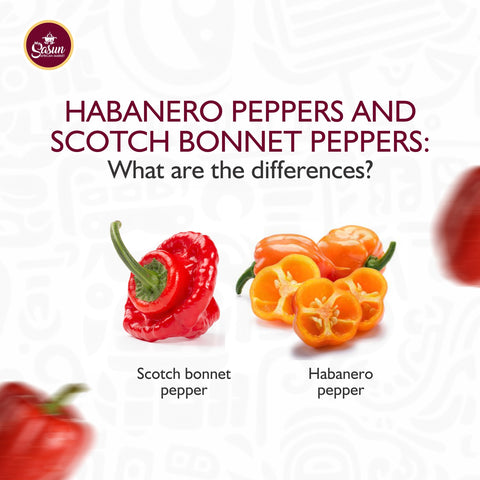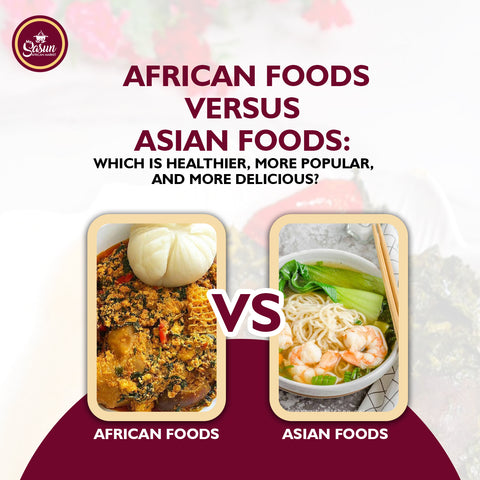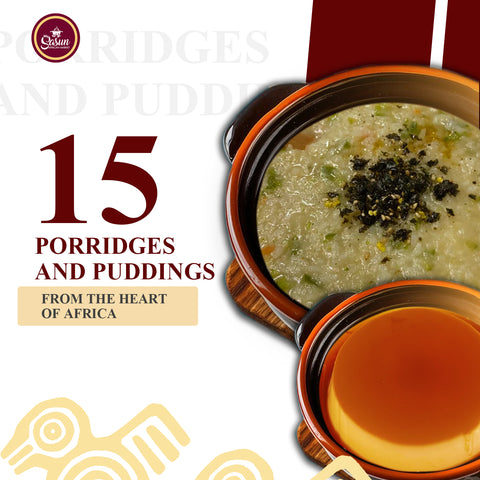Habanero peppers and Scotch Bonnet peppers are integral to many African cuisines, known for their intense heat and distinctive flavors. These peppers, while similar in some respects, have unique characteristics that make them special. In this article, we will explore the origins, characteristics, culinary uses, and health benefits of both peppers, with a particular focus on their role in African cooking. For those looking to add these fiery ingredients to their kitchen, My Sasun African Store offers a great selection of both Habanero and Scotch Bonnet peppers.
Also Read: 15 Porridges and Puddings from the Heart of Africa
Habanero Peppers

Habanero peppers originally hail from the Amazon basin, spreading to Central America and Mexico. They were introduced to Africa through trade routes and have since become a staple in many African dishes. The name "Habanero" is derived from Havana, Cuba, highlighting its widespread trade history.
Buy your box of Orange Habanero here
Characteristics of Habanero Peppers
Habaneros are small, lantern-shaped peppers that come in various colors, including orange, red, yellow, and brown. They typically measure between 2 to 6 centimeters in length and have a smooth, waxy skin.
Varieties of Habanero Peppers
Several varieties of Habanero peppers are:
- Red Savina Habanero: Known for its extreme heat.
- Chocolate Habanero: Offers a unique smoky flavor.
- Caribbean Red Habanero: Slightly sweeter than the traditional orange Habanero.

Nutritional Value of Habanero peppers
Habanero peppers are rich in vitamins and minerals, particularly Vitamin C and Vitamin A. They also contain capsaicin, which provides various health benefits.
Buy a quarter box of Orange Habanero here
Scotch Bonnet Peppers

Scotch Bonnet peppers are native to the Caribbean but have found a beloved place in African cuisine. They are named for their resemblance to the Tam o' Shanter hat, a traditional Scottish bonnet. In Africa, they are commonly used in West African and Central African dishes.
Characteristics of Scotch Bonnet Peppers
These peppers are similar in size to Habaneros but have a more rounded, squat shape. They are typically bright red or yellow, with a wrinkled appearance.
Varieties of Scotch Bonnet Peppers
- Jamaican Scotch Bonnet: The classic, fiery variety used in many Caribbean and African dishes.
- MOA Scotch Bonnet: Known for its slightly milder heat and fruitier flavor.
Nutritional Value of Scotch Bonnet Peppers
Like Habaneros, Scotch Bonnets are packed with vitamins and minerals, especially Vitamin C. They also contain antioxidants and capsaicin.
Comparing Heat Levels of Scotch Bonnet peppers and Habanero Peppers
The Scoville scale measures the heat of peppers in Scoville Heat Units (SHU), quantifying the concentration of capsaicinoids, the compounds responsible for the spiciness.
Habanero peppers typically range between 100,000 to 350,000 SHU, making them one of the hotter varieties of chili peppers. Scotch Bonnets also range between 100,000 to 350,000 SHU, although some varieties can be slightly milder or hotter.
Get your different types of stew blends here
Flavor Profile of Scotch Bonnet peppers and Habanero Peppers

Habanero peppers have a fruity, citrus-like flavor with floral notes. Their intense heat is often complemented by their sweet undertones while Scotch Bonnets have a similar fruity taste but with a more pronounced sweetness and a hint of apple or cherry-like flavor, which makes them a favorite in African and Caribbean dishes.
The unique flavors of these peppers make them ideal for specific dishes:
- Habaneros: Often used in salsas, hot sauces, and marinades for their sharp heat and fruity notes.
- Scotch Bonnets: Commonly used in African stews, sauces, and pepper soups for their sweet, fruity flavor and vibrant heat.
Popular Dishes with Habanero Peppers
Habanero peppers are used in a variety of African dishes, including:
- Suya: A spicy meat skewer marinated with habanero pepper sauce.
- Pepper Soup: Adds a fiery kick to this traditional West African soup.
- Chili Sauces: Enhances the heat and flavor of various sauces.
Buy a box of Red Habanero here
Popular Dishes with Scotch Bonnet Peppers

Scotch Bonnet peppers are integral to African cuisine, including:
- Jollof Rice: Adds a spicy and sweet flavor to this iconic dish.
- Egusi Soup: Enhances the rich flavors of this Nigerian favorite.
- Pepper Sauce: A versatile condiment used across many African countries.
Substituting One for the Other
While both peppers can be used interchangeably in some recipes, their distinct flavors can alter the dish's final taste. When substituting, consider the flavor profile and adjust other ingredients accordingly.

Health Benefits
Vitamins and Minerals
Both Habanero and Scotch Bonnet peppers are excellent sources of Vitamins A and C, which are crucial for immune function and skin health.
Capsaicin and Metabolism
Capsaicin, the compound responsible for the heat in these peppers, has been shown to boost metabolism and aid in weight loss by increasing energy expenditure.
Antioxidant Properties
The antioxidants found in these peppers help combat oxidative stress, reducing the risk of chronic diseases such as heart disease and cancer.
Digestive Health
Capsaicin can stimulate the digestive system and improve gut health, though it may cause discomfort in some individuals with sensitive stomachs. The peppers' high fiber content also aids in digestion.
Buy a box of Green Habanero here
Selecting Fresh Peppers
When buying habanero or Scotch Bonnet peppers, look for firm, glossy skin with no signs of wrinkles or blemishes. The peppers should feel heavy for their size, indicating juiciness.

Storage Tips
Store fresh peppers in the refrigerator in a plastic bag or airtight container. They can last up to two weeks when stored properly.
For longer storage, consider drying or freezing the peppers. To dry, hang them in a well-ventilated area or use a food dehydrator. To freeze, wash and dry the peppers, then place them in a freezer bag, removing as much air as possible before sealing.
Dried peppers can last for several months to a year if kept in a cool, dark place. Frozen peppers retain their quality for about six months.
Handling Hot Peppers Safely
Always wear gloves when handling habanero or Scotch Bonnet peppers to avoid skin irritation. Be careful not to touch your face, especially your eyes, after handling the peppers.
Enhancing Flavor in Dishes
To enhance the flavor of dishes, consider roasting or charring the peppers before using them. This adds a smoky depth to their natural sweetness.
Balancing Heat and Flavor
If a dish is too spicy, add a sweet element like honey or sugar to balance the heat. Dairy products like yogurt or sour cream can also help mellow the spiciness.
Avoiding Common Mistakes
- Overusing Peppers: Start with a small amount and adjust to taste to avoid overwhelming the dish.
- Ignoring Heat Levels: Different peppers have varying heat levels, so always taste a small piece before adding it to your dish.
Conclusion

Habanero and Scotch Bonnet peppers, while both extremely hot, offer unique flavors. Their distinct heat levels and flavors make them invaluable in African cuisine. By understanding their differences and proper handling, you can elevate your cooking and enjoy the rich, spicy flavors they bring to the table. If you’re looking to spice up a traditional African dish or experiment with new recipes, My Sasun African Store provides high-quality Habanero and Scotch Bonnet peppers to enhance your culinary adventures. Explore the variety of Habanero and Scotch Bonnet peppers available at My Sasun African Store, and discover new ways to incorporate these fiery ingredients into your cooking.







Comments (4)
I would never have believed that cold sore herpes virus can be cured with ancient herbal medicine because I just tested negative for the second time since I finished drinking the medicine a herbal doctor sent to me, all the sores and blisters were gone immediately I started drinking the herbal meds, so I want you all to know that herpes virus can be cured with the right use of ancient herbal medicine so visit this herbalist called doctor excel on his Email: drahonsie00@gmail.com / WhatsApp: +2348039482367. https://drahonsie002.wixsite.com/dr-ahonsie https://www.facebook.com/drstellaherbalhome?mibextid=ZbWKwLThanks
Hello everyone, i have a very important information about herpes virus, i was a victim of hsv1&2 until i met doctor Ahonsie, it still feels like a dream to me. it has been two years now, i have not experience any breakout of herpes. I new about him through a post made on social media, a lady shares her experience and then i decided to contact him and ever since i contacted i was encourage and with no doubt i was cured from herpes simplex in just two weeks. He also treat other illnesses like HPV, HIV, CANCER, THYRIOD, PENIS ENLARGEMENT, and more contact him via Email: drahonsie00@gmail.com / WhatsApp: +2348039482367. https://drahonsie002.wixsite.com/dr-ahonsie https://www.facebook.com/drstellaherbalhome?mibextid=ZbWKwLThanks
My purpose out here today is to share this article to the world about how Doctor Odunga helped me in getting back my EX-boyfriend who broke up with me 4 months ago. I tried all I could to make him see reasons with me so that we can continue our relationship but he denied me. Thank God for giving me the thought of going into the internet for help, I searched properly and I saw different reviews of Doctor Odunga and I insisted on giving it a try by contacting him via what’s app on (+2348167159012). He gave me reason to live again and he prepared a spell and told me that my Ex-boyfriend will come back to me within 11 hours. Can you believe it, my EX-boyfriend came back to me, proposed to me and our wedding will be held soon. Contact him now!!! if you need any help. Email: odungaspelltemple@gmail.com and he does a lot of spells. Once again i want to say am very grateful for your help
Am really grateful and thankful for what Dr Ahonsie has done for me and my family. I Was having HERPES for good three years with no solution, the diseases almost took my life and because I was unable to work and I was also loosing lots of money .for medication, but one faithful day when I went online, I met lots of testimonies about this great man so I decided to give it a try and to God be the glory he did it. he cured me of my diseases and am so happy and so pleased to Write about him today. if you need his help or you also want to get cured just the way I got mine, just email him below drahonsie002@gmail.com You can also call or whatsApp his telephone number on +2348039482367. https://drahonsie002.wixsite.com/dr-ahonsie https://www.facebook.com/drstellaherbalhome?mibextid=ZbWKwLThanks once again Dr Ahonsie.